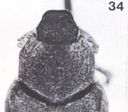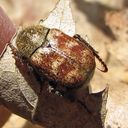Monkey Beetles
Hoplia
Classification
- Phylum: Arthropoda
- Subphylum: Hexapoda
- Class: Insecta
- Order: Coleoptera
- Suborder: Polyphaga
- Superfamily: Scarabaeoidea
- Family: Scarabaeidae
- Subfamily: Melolonthinae
- Tribe: Hopliini
- Genus: Hoplia
Pronunciation
How to pronounce Hoplia: /ˈhɑplia/
These audio files are automatically generated. While they are not always 100% accurate, they are a good starting point.
Images





Summary
Hoplia is the largest genus of monkey beetles, comprising at least 300 described species found across Asia, Europe, South Africa, Madagascar, and the Americas. They are recognized for their role in pollination and can impact agriculture when certain species become pests.
Physical Characteristics
7‒12 mm in length.
Identification Tips
Adults are distinguished by their wide, flat bodies and often vibrant coloration.
Habitat
Adults are typically found in gardens, parks, and meadows where flowers and foliage are abundant.
Distribution
Eurasia, Africa, and the New World. In specific regions, 5 species are found in the western area, 3 are restricted to southeastern US, and 4 are more widely spread in the eastern regions.
Diet
Adults feed on flowers and foliage, while larvae feed on the roots of various plants.
Life Cycle
Larvae hibernate in a late instar and pupate in the soil during spring. Adults emerge in spring.
Ecosystem Role
Pollinators as adults; larvae contribute to soil health by breaking down organic matter.
Economic Impact
Some species, particularly H. callipyge, are considered pests affecting ornamentals and grapevines.
Collecting Methods
- Visual spotting on flowers and foliage
- Trapping using baited methods
Preservation Methods
- Dry preservation in envelopes
- Ethanol preservation for larvae
Similar Taxa
Misconceptions
They are often confused with other beetles that feed on similar plants but are not true monkey beetles.
Tags
- monkey beetles
- Hoplia
- Scarabaeidae
- Coleoptera
- pests